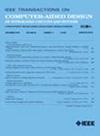Area-Oriented Resubstitution For Networks of Look-Up Tables
IF 2.7
3区 计算机科学
Q2 COMPUTER SCIENCE, HARDWARE & ARCHITECTURE
IEEE Transactions on Computer-Aided Design of Integrated Circuits and Systems
Pub Date : 2025-01-03
DOI:10.1109/TCAD.2025.3525617
引用次数: 0
Abstract
This article addresses the challenge of reducing the number of nodes in look-up table (LUT) networks with two significant applications. First, field-programmable gate arrays (FPGAs) can be modeled as networks of LUTs, and minimizing the node count is imperative to meet resource constraints. Second, in area-oriented design space exploration for standard-cell designs, collapsing a circuit into a LUT network, restructuring it, and later remapping to the original representation helps escape local minima. Thus, the development of algorithms for optimizing and restructuring LUT networks holds considerable promise for area-oriented optimization. Substitution (also called resubstitution) is a powerful logic minimization method that can identify nonlocal logic dependencies and exploit them for logic minimization. State-of-the-art substitution algorithms for LUT networks rely heavily on SAT solving, limiting the number of optimization attempts and the size of the substitution subnetworks to one node面向区域的查询表网络再替换
本文通过两个重要的应用程序解决了减少查找表(LUT)网络中节点数量的问题。首先,现场可编程门阵列(fpga)可以建模为lut网络,最小化节点数是满足资源限制的必要条件。其次,在面向区域的标准单元设计空间探索中,将电路折叠成LUT网络,对其进行重组,然后重新映射到原始表示有助于避免局部最小值。因此,优化和重构LUT网络的算法的发展对面向区域的优化具有相当大的前景。替代(也称为再替代)是一种功能强大的逻辑最小化方法,它可以识别非局部逻辑依赖并利用它们进行逻辑最小化。用于LUT网络的最先进的替代算法严重依赖于SAT求解,将优化尝试的次数和替代子网的大小限制在一个节点[1]。相反,我们的方法依赖于电路模拟来增加替代候选的数量,并允许使用多个节点进行替换。实验结果表明,所提出的方法识别了被其他方法忽略的优化机会,在EPFL合成竞赛中提高了23个最知名结果中的11个,与最先进的结果相比,面积减少了3.46%。
本文章由计算机程序翻译,如有差异,请以英文原文为准。
求助全文
约1分钟内获得全文
求助全文
来源期刊
CiteScore
5.60
自引率
13.80%
发文量
500
审稿时长
7 months
期刊介绍:
The purpose of this Transactions is to publish papers of interest to individuals in the area of computer-aided design of integrated circuits and systems composed of analog, digital, mixed-signal, optical, or microwave components. The aids include methods, models, algorithms, and man-machine interfaces for system-level, physical and logical design including: planning, synthesis, partitioning, modeling, simulation, layout, verification, testing, hardware-software co-design and documentation of integrated circuit and system designs of all complexities. Design tools and techniques for evaluating and designing integrated circuits and systems for metrics such as performance, power, reliability, testability, and security are a focus.

 求助内容:
求助内容: 应助结果提醒方式:
应助结果提醒方式:


